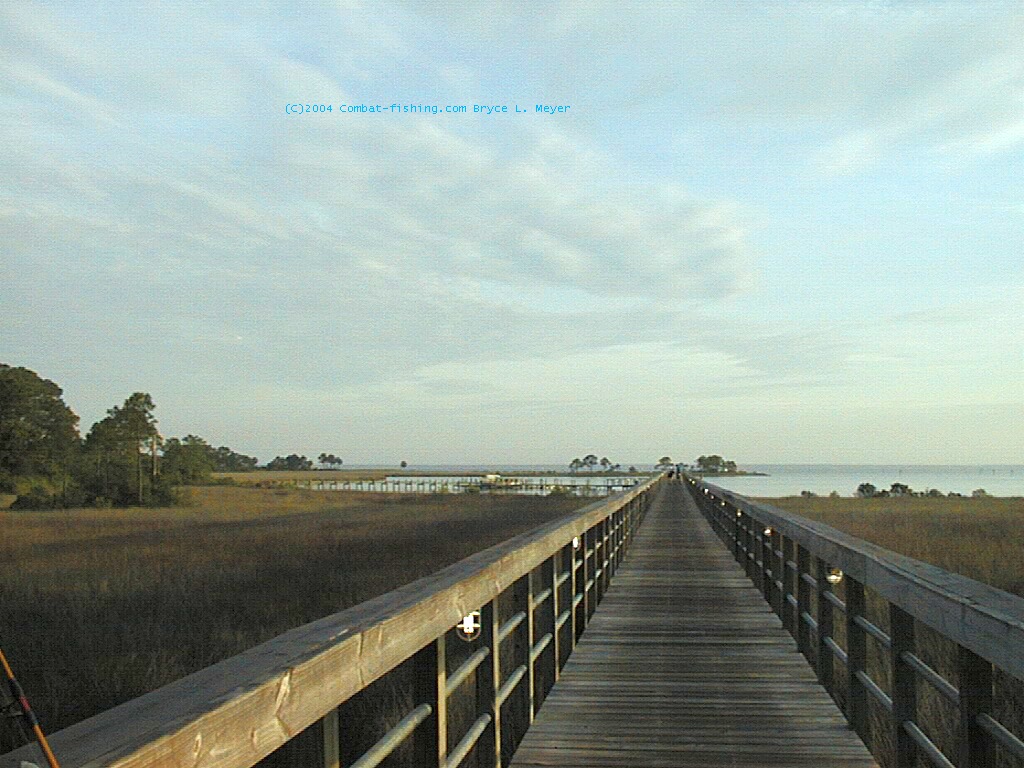









Nav:HOME ---- Fish Biology and Ecology ---- Ecology of Choctawhatchee Bay Florida(YOU ARE HERE)
Latest Reports |
Fishing Articles |
Fishing Tactics |
Fish Ecology and Biology |
Travel Articles |
Fishy Fun |
External Links |
Shopping |
HOME
The
Ecology of Santa Rosa Sound and Choctawhatchee Bay

Introduction
and Tide Flow
Like any bay of the south eastern
U.S., Choctawhatchee Bay and Santa Rosa Sound are sandy, shallow, greenish-brown
expanses of brackish water surrounded by marsh grasses and oyster beds.
At the east end of the bay, the Choctawhatchee River winds its way through
a swamp to dump its tannic stained water into the bay. At the west
end of the bay, Santa Rosa Sound connects the bay to Pensacola Bay, as
a 40 mile long saltwater river that daily reverses course on the tide change.
At the south end of the bay is the Destin Pass into the Gulf of Mexico.
The arrangement of these passes and saltwater channels forces large shift
in the salt concentrations of the bay on each tide, making the growth of
some type of sea grasses impossible.
 Incoming tide water flow (blue=saltwater,
green=freshwater)
Incoming tide water flow (blue=saltwater,
green=freshwater)
 Outgoing tide water flow (green=freshwater,blue-green=brackish
water)
As a result only patches of brown
sea grass grow underwater and only in shallow flats on the bay, and small
patches of oyster beds grow, leaving much of the bay bottom
bare mud&sand. As a result, aquatic life in the bay hugs the
marshes on the edges of the bay, around bridges/pillings and piers, and
around these patches of grass and oysters. The large fishes, which
cannot always hugs this sparse cover, hug drop offs and tide current edges
in the passes and channels.
Back to the Top
Outgoing tide water flow (green=freshwater,blue-green=brackish
water)
As a result only patches of brown
sea grass grow underwater and only in shallow flats on the bay, and small
patches of oyster beds grow, leaving much of the bay bottom
bare mud&sand. As a result, aquatic life in the bay hugs the
marshes on the edges of the bay, around bridges/pillings and piers, and
around these patches of grass and oysters. The large fishes, which
cannot always hugs this sparse cover, hug drop offs and tide current edges
in the passes and channels.
Back to the Top
THE
ENERGY (FOOD) WEB OF THE BAY
(see diagram below
)
All ecosystems are linked by how food
energy is passed from smaller organisms, to larger organisms that eat the
smaller organisms. Each layer of organisms are called Tiers. Each
tier can consume all tiers below it. The higher the tier number,
the farther up the food chain you are, terminating here with Tier 6.
People are by far, the highest predator on the list, but since we are concerned
with the aquatic system, we will start below the 'People' level.
Like all ecosystems, the energy that drives all life in the bay starts
with the sun (Tier 0). The solar energy is used by microscopic plants
or Phytoplankton (Tier 1) to build themselves and drive their lives.
Slightly larger animals, such as immature crabs, oysters, fishes, along
with rotifers and microscopic shrimps eat these phytoplankton and are lumped
together as 'zooplankton' on Tier 2. Another addition to the second
tier is the mullet, which though much larger than other members of Tier2,
eats only phytoplankton and algae. Yet another filter feeder on Tier
2 are oysters and clams. Larger than all but the mullet, are other animals
that eat the zooplankton, such as shrimp, baitfish (glass minnows, sailfin
mollies, shad, herring, menhaden, etc.), small blue crabs and sand
crabs, form Tier 3. Tier 4 is formed by large blue crabs (over 3"
in width), squid (which eat minnows and shrimps), and smaller predators
such as pinfish, grunts, atlantic croakers, sheepheads, sand perch,
lizardfish, blue runners, and smaller grey and lane snappers. Tier 5 hold
the bulk of inshore saltwater gamefish: Striped Bass, Drums ( Redfish,
Speckled Trout, Black Drum), Largemouth bass (which venture into the fresher
northern parts of the bay), Bluefish (summer), Spanish Mackerel (summer)
Jack Crevalle (summer migrants ), tarpons (including Ladyfish-summer),
flounder, and grouper. The top of the aquatic end of the web, Tier
6, includes the top aquatic predators: Porpoises and Dolphins (the mammal),
Alligator Gar, and Sharks.
What's this all mean
for anglers?
1) Timing-the fish you are pursuing
will move to the salinity level that suits them best, or suits their prey
best.
2) Baits and Lures: The food gamefish
pursue will likely be in 1 to 2 tier below them-make the baits and lure
match accordingly.
 Back to Top
Back to Top
Back to Top
LEGAL: ALL content ©1993-2015 Bryce L. Meyer. The term "Combat-Fishing" is a federally registered trademark. The camo fish and pole is a trademark. "Combat Fishing" when used in reference to travel information on the web or book, fishing websites, books, or sim is also a trademark.













